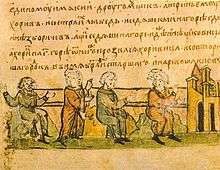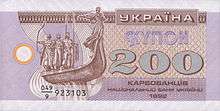Kyi, Shchek and Khoryv
Kyi, Shchek and Khoryv (Ukrainian: Кий, Щек, Хорив [ˈkɪj ˈʃtʃɛk xoˈrɪu̯]; Old East Slavic: Кыи, Щекъ, Хоривъ) were three legendary brothers - often mentioned along with their sister Lybid (Ukrainian: Либідь [ˈlɪbidʲ]; Old East Slavic: Лыбѣдь) - who, according to the Primary Chronicle,[1] founded the medieval city of Kiev, which eventually became the capital of present-day Ukraine. There is no precise and historically established information about the rule of Kyi and the establishment of the city of Kiev.[2]


Historical background
In the Primary Chronicle which is traditionally believed to have been written by a monk of Kiev Cave Monastery by the name of Nestor and finished in 1113, a special place is held by the legend about the foundation of Kiev by three brothers.[2] In the legend, Nestor places those brothers onto various hills of Kyiv.[2] Geographically, the old Kiev is located on a higher right bank of Dnieper which is an extension of the Dnieper Upland where remnants of the Church of the Tithes are located.
The Chronicle further states that there were people ("who did not know what were saying") who considered Kyi a mere ferryman.[2] But, then it argues that Kyi as a prince of his gens was visiting Czargrad and received great honors from the Emperor.[2] Dmitry Likhachov combined attestations of the Nikon Chronicle which also indicates that Kyi with a great army marched onto Czargrad and received great honors from the Emperor.[2] During his expedition to Constantinople, Kyi also found a city of Kyivets on the Danube.[2]
Nestor also names the approximate date of the assault on Kiev by the Khazar Empire as "after the death of Kyi" which confirms the hypothesis of Boris Rybakov, 6th-7th centuries.[2] In his chronicle Nestor does not indicate the date of Kyi's death nor the existence or absence of his heirs who continued to rule after his death.[2] The chronicle does mention a meeting between local residents with the arrived Askold and Dir who asked them referring to Kiev, whose city it was and received the answer that the three brothers who built it were long dead and the residents now paid tribute to the Khazars.[2] However, the Polish historian Jan Długosz drew attention to the Przemysł Chronicle that asserts "after the death of Kyi, Shchek, and Khoryv their children and grandchildren who descended from them by direct lineage ruled for many years".[2]
Excerpt from the Russian Primary Chronicles
Полѧномъ же живущиим̑ ѡ собѣ. и вла̑дѣющимъ роды своим̑ . ӕже и до сеӕ брат̑ӕ бѧху Полѧне . и живѧху кождо съ родом̑ своимъ . на своихъ мѣстехъ . володѣюще кождо родомъ своимъ ❙ И быша . г҃ . брата . а А єдиному имѧ Кии . а другому Щекъ . а третьєму Хоривъ . и сестра ихъ Лыбѣдь . и сѣдѧше Кии на горѣ кдѣ н҃нѣ оувозъ Боричевъ . а Щекъ сѣдѧше на горѣ . кдѣ ннѣ зоветсѧ Щековица . а Хоривъ на третьєи горѣ . ѿнюдүже прозвасѧ Хоривıца . створиша городокъ . во имѧ брата ихъ старѣишаго . и наркоша и Києвъ . и бѧше ѡколо города лѣсъ и боръ великъ . и бѧху ловѧще звѣрь . Б бѧхуть бо мудрѣ и смыслени. и нарицихусѧ Полѧне .
— ЛѢТОПИСЬ ПО ИПАТЬЕВСКОМУ СПИСКУ, ПСРЛ. — Т. 2. Ипатьевская летопись. — СПб., 1908. — Стлб. 1-21.[3]
Translation by Dmitry Likhachov
In those times Polyans lived separately and were governed by own family clans; and so those brethren (of whom we will talk further) were also Polyans and all they lived by family clans in own places and each was governed independently. And there were three brothers: one was named Kyi, another – Shchek and third – Khoryv, and their sister – Lybid. See of Kyi was the hill where today is Borychiv Descent, and see of Shchek was the hill which today is called Shchekovytsia, and Khoryv on the hill which was named after him Khoryvytsia. And they built a city in honor of their older brother and called it Kiev. Around the city there was a great forest and thicket and there were hunting for beasts and were those men wise and reasonable and they were called Polyans, from them the Polyans are to this day in Kiev.
— Dmitry Likhachov, Story about establishing of Kiev. Primary Chronicles (ПРЕДАНИЕ ОБ ОСНОВАНИИ КИЕВА. Повесть временных лет)[4]
Translation by Samuel Hazzard Cross
While the Polyanians lived apart and governed their families (for before the time of these brothers there were already Polyanians, and each one lived with his gens on his own lands, ruling over his kinsfolk), there were three brothers, Kiy (sic!), Shchek, and Khoriv, and their sister was named Lybed’. Kiy (sic!) lived upon the hill where the Borichev trail now is, and Shchek dwelt upon the hill now named Shchekovitsa, while on the third resided Khoriv, after whom this hill is named Khorevitsa. They built a town and named it Kiev after their oldest brother. Around the town lay a wood and a great pine-forest in which they used to catch wild beasts. These men were wise and prudent; they were called Polyanians, and there are Polyanians descended from them living in Kiev to this day.
— Samuel Hazzard Cross and Olgerd P. Sherb owitz-Wetzor, The Primary Chronicle (Laurentian Text)[5]
Archaeological excavations

Archaeological excavations have shown that there was indeed an ancient settlement starting with the 6th century. Some speculate that Kyi was a real person, a knyaz (prince) from the tribe of the Polans. According to legend, Kyi, the eldest brother, was a Polianian Prince, and the city was named after him.[6]. As well, the legend says that the appearance of a large city on the hilly banks of the Dnieper was predicted by Andrew the Apostle.
Historiographical interpretation
Many historians consider as truthful the existence of Kyi and his princely rule around the 6th century.[2] Among such historians are Boris Rybakov, Dmitry Likhachov, Aleksey Shakhmatov, Alexander Presnyakov, Petro Tolochko, Nataliia Polonska-Vasylenko, and others.[2]
The legend personal names have similar equivalents from an Armenian chronicle from the 7th century, History of Taron, by Zenob Glak. In it, two Kievan brothers Kyi and Khoryv have almost the same counterparts in brothers Kouar and Horian, while Polyans have it in district Balounik.[7] The legend also has parallels in the Croatian origo gentis of five brothers and two sisters (Kloukas, Lobelos, Kosentzis, Mouchlo, Chrobatos, Touga and Bouga) from the 30th chapter of De Administrando Imperio by Constantine VII (10th century), and the Bulgarian apocryphal chronicle (12th century) about the ethnogenesis of the Bulgarians. All three speak about people who migrated to a foreign land, whose leader was of the same name (Kyi in Kiev, Chrobatos in Croats, and Slav in Bulgarians), while Kievan and Croatian mention a sister.[7] The female personality and number three can be found also in three daughters (youngest Libuše) of Duke Krok from Chronica Boemorum (12 century), two sons and daughter (Krakus II, Lech II, and Princess Wanda) of Krakus legendary founder of Kraków from Chronica seu originale regum et principum Poloniae (12-13th century), and three brothers Lech, Czech, and Rus from Wielkopolska Chronicle (13th century).[7]
Khoryv or Horiv, and his oronym Khorevytsia, some scholars related to the Croatian ethnonym of White Croats.[8][9][10] Paščenko related his name, beside to the Croatian ethnonym, also to solar deity Hors.[10] Near Kiev there is a stream where previously existed a large village named Horvatka or Hrovatka (it was destroyed in the time of Joseph Stalin), which flows into Stuhna River.[11]
Modern tributes

In addition to the respective hills and the river, there are Shchekavytska and Khoryva Streets in Kiev's ancient neighborhood of Podil.
In 1982, Kyi, Shchek, Khoryv and Lybid were depicted (standing on an ancient riverboat) in a sculpture at the river-side of Navodnytsky Park. The monument, created by Vasyl Borodai, soon became iconic for the city and has been used as Kiev's unofficial emblem. In the 2000s another statue was installed at the central square, Maidan Nezalezhnosti.
See also
References
- "An Armenian historian of the seventh century, Zenob Glak, knew of a similar legend concerning the founding of the city of Kuar (Kiev) in the land of Poluni (Polianians) by three brothers Kuar, Mentery, and Kherean." [in:] Medieval Rus' epics, chronicles, and tales. 1974; "Similarly to Nestor's story about Kyi, Shchek and Khoryv, the Armenian legend of Kuar and his brothers says (in the 6th or in the 7th century). [in:] Київ, анциент анд модерн киты. 1983
- Oleh Yastrubov. "And gave it its name Kyiv". Newspaper "Den". 14 July 2006.
- http://litopys.org.ua/ipatlet/ipat01.htm
- http://www.hrono.info/dokum/1000dok/povest1.php
- https://archive.org/stream/TheRussianPrimaryChronicle/the%20russian%20primary%20chronicle_djvu.txt
- http://www.ukrainians-world.org.ua/eng/peoples/ff653263602957f1/
- Lajoye, Patrice (2019). "Sovereigns and sovereignty among pagan Slavs". In Patrice Lajoye (ed.). New Researches on the Religion and Mythology of the Pagan Slavs. Lingva. pp. 165–181. ISBN 979-10-94441-46-6.
- Malyckij, Oleksandr (2006). "Hrvati u uvodnom nedatiranom dijelu Nestorove kronike "Povijest minulih ljeta"" [Croats in the introductory non-dated part of the Nestor's chronicle "History of the past years"]. In Nosić, Milan (ed.). Bijeli Hrvati I [White Croats I] (in Croatian). Maveda. pp. 106–107. ISBN 953-7029-04-2.
- Jaroslav Rudnyckyj (1982). An Etymological Dictionary of the Ukrainian Language: Parts 12–22 (in English and Ukrainian). 2. Winnipeg: Ukrainian Free Academy of Sciences (UVAN). p. 968.
- Paščenko, Jevgenij (2006), Nosić, Milan (ed.), Podrijetlo Hrvata i Ukrajina [The origin of Croats and Ukraine] (in Croatian), Maveda, pp. 99–102, 109, ISBN 953-7029-03-4
- Strižak, Oleksij (2006). "Sorbi, Srbi, Hrvati i Ukrajina" [Sorbs, Serbs, Croats and Ukraine]. In Nosić, Milan (ed.). Bijeli Hrvati I [White Croats I] (in Croatian). Maveda. pp. 106–107. ISBN 953-7029-04-2.
External links
- Основатели Кий, Щек и Хорив и их сестра Лыбедь, князья Аскольд и Дир
- A HISTORY OF UKRAINE. EPISODE 14. THE FOUNDING OF KYIV
- Dmytro Lavrov. How many years has Kiev (СКІЛЬКИ РОКІВ МІСТУ КИЄВУ?). The Mirror Weekly. 28 May 2004
- Mykola Kotlyar. Kiev princes Kyi and Askold (КИЇВСЬКІ КНЯЗІ КИЙ І АСКОЛЬД). Magazine "Voyenna istoriya". 2002